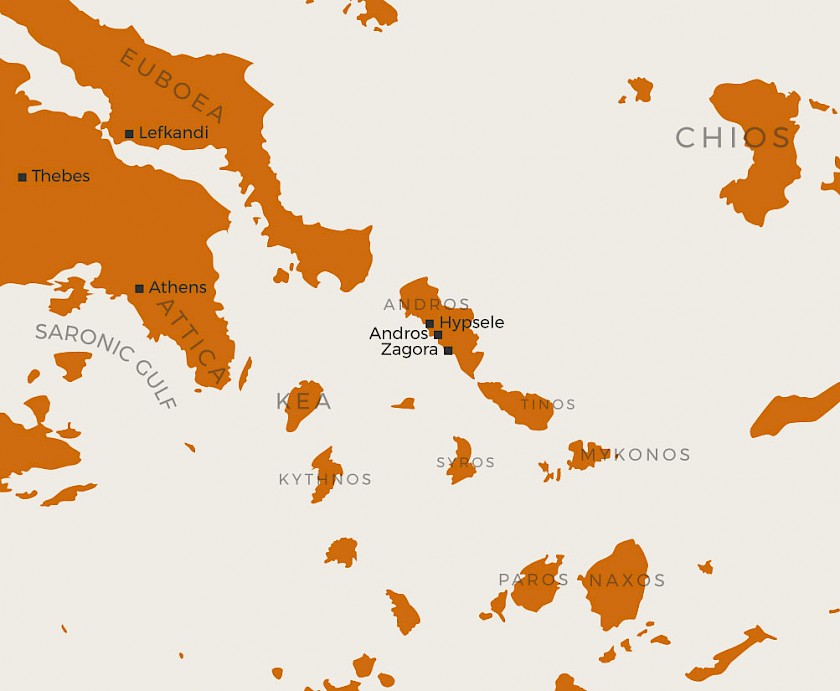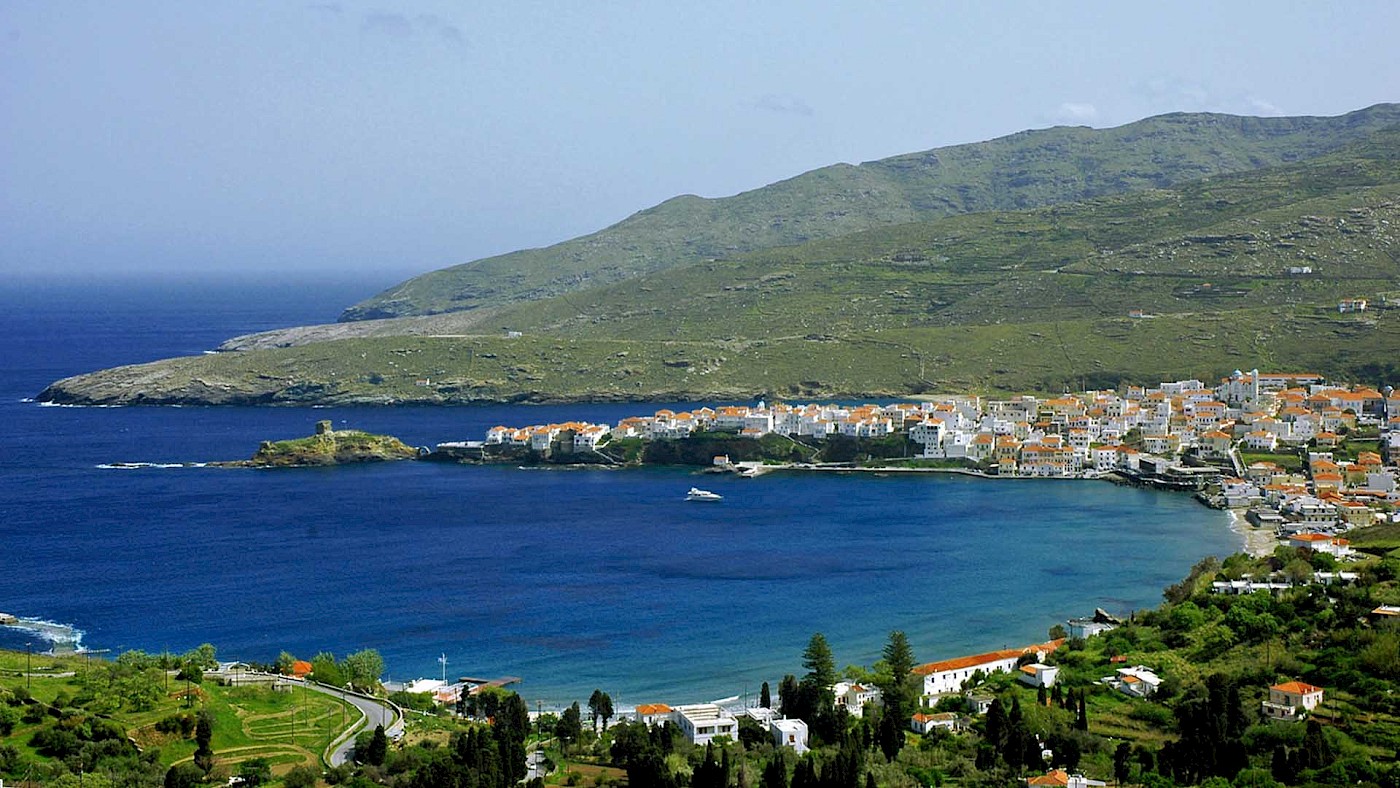The Aegean island of Andros is one of the northernmost of the Cyclades, close to Attica and Euboea. In the Early Iron Age, there are three known settlements on Andros: Zagora, Hypsele, and the city of Andros (modern Palaiopolis). These settlements, founded between the tenth and eighth centuries BC, form a route along the west coast of Andros, facing towards Attica and Euboea.
Zagora and Hypsele were located on steep plateaux, while Andros was on the flat coastal plain. The plateau settlements constructed fortification walls in the eighth century, perhaps to protect themselves from one another, and both were abandoned – Zagora completely, except for its sanctuary of Athena; Hypsele only partially – around 700 BC, as Andros expanded.
Prelude: Andros in the Early Iron Age
Zagora is a small settlement, not quite seven hectares, with a population estimated between 90 and 375 inhabitants, depending on proposed density of occupation, towards the end of the eighth century BC (Hall 2014, p. 75). Most of the houses are “Megaron”-style (a single room with a porch) in the earlier eighth century, but after ca. 725 BC they are remodelled into multi-room structures.

Ian Morris suggested that this reorganization reflects a transformation of society from open communities to closed households, which he took to reflect hardening gender ideologies (Morris 1999). Lin Foxhall, however, interprets this remodelling as reflecting the changing needs of families over their lifecycles and suggests that they may reflect large, kin-based homes (Foxhall 2009, pp. 498-500); a proposal that supports the suggestion that the entire plateau was densely occupied immediately before its abandonment.
Life at Zagora is unlikely to have been comfortable. The site is exposed to both summer and winter winds from the north and there is no spring water available within the walled environment. Its advantages are that it is well protected from attack – and well-positioned to launch an attack on passing ships (Green 1990, p. 45). Furthermore, the plateau is flat, meaning that it was easier to expand to fill the available space compared to Andros/Palaiopolis, which required terracing of the sloped landscape (Morgan 2012, p. 40).
Zagora has been called both a colony and a trading station of Eretria on Euboea – a stopping off point on their way east (Coldstream 2003, pp. 199-200; 210-12). Alternatively, Antonis Kotsonas has argued that Zagora’s history makes much more sense in the local Andrian context than as a significant connecting node. Its connections are not spectacular; besides the usual big names in the eighth century Aegean – Athens, Euboea, Corinth – the main source of imports are its neighbouring Cycladic islands. Kotsonas contrasts this to Thera on Santorini, which has a much wider range of imported fine-wares and transport amphorai, and is thus likely to have been a much more significant node from the eighth century BC (Kotsonas 2012).
As far as local production is concerned, the presence of large pithoi indicates diversified agricultural production, presumably in the inland valleys of the island. Storage appears to have taken place in the household – in the excavated settlement, every house has pithoi – rather than centralized control that might have facilitated long-distance trade.
Hypsele is less prominent in scholarship than its neighbour, but it has nevertheless been extensively excavated. (Excavation data from Hypsele is summarized in Televantou 2012.) It is much smaller than Zagora, covering only 1.5 ha: 10,000 m² acropolis and a lower town of 5,000 m². The acropolis was fortified on three sides – south, north, and east – and buildings on the acropolis abut these walls. The sanctuary on the acropolis appears to have been dedicated to Demeter and the northern slope of the acropolis, exposed to the winds, appears largely to have been terraced for farming.
Unlike Zagora, Hypsele remained inhabited from the seventh century BC until the fifth, and possibly later. However, the settlement outside the acropolis was abandoned, and the sanctuary remodelled and expanded to cover much of the occupied space (450 m²). As at Zagora, the sanctuary continued to function until after the abandonment of the site. Hypsele overlooks the main sea routes from Euboea and Attica – alongside the expanded Andros/Palaiopolis, it may have provided security to the Archaic polis (Morgan 2012, p. 40).
Synoikismos
Little is known of the Iron Age settlement Andros/Palaiopolis, partially because it remained occupied for many more centuries. Zagora and Hypsele, meanwhile, were largely abandoned around 700 BC, which is one of the reasons why the former has been so important to early Greek archaeology.
The late eighth century abandonments of Zagora and Hypsele is widely regarded as evidence of synoikismos, a process by which a new polis is created by merging neighbouring communities while the old settlements are largely abandoned, except for their sanctuaries (Hall 2014, pp. 78-79).
The city of Andros (modern Palaiopolis) was located on an area of the coast with good harbours, and its agora developed on the sea front, suggesting that the abandonment of the plateau settlements may have been to facilitate better access to the expanding trade routes of the seventh-century Aegean.
Furthermore, defensible sites like Zagora and Hypsele seem no longer to have been necessary: there is no fortification wall around the Andros until the fourth century BC. That Andros was prosperous – although never one of the leading poleis – is suggested by the colonies founded in the Chalcidice with which it is credited by ancient authors (Thuc. 4.84.1, 103.3, 109.3; 5.6.1).
Significance
A number of factors make eighth-century events on Andros significant. The first is the clarity with which it can be said that Zagora was abandoned by choice, not force, indicated by the lack of movable objects or completely preserved pots reported by the excavators. It is not clear what provoked this abandonment. The excavators suggested that an earthquake could have caused disruption to the water supply to the site, while Nicholas Coldstream suggested that trade contacts were made more difficult as a result of the (semi-mythical) Lelantine War on Euboea. (On the Lelantine War: Hall 2014, pp. 1-8.)
However, continued occupation at Hypsele and the expansion of Andros/Palaiopolis from 700 BC suggest a much more positive probability: the decision to settle in a larger community with much greater access to the Aegean. Catherine Morgan points out that as social hierarchy began to develop, the limited space at Zagora limited the expression of power through the layout of the household (Morgan 2012).
This relocation may have been the result of difficulty trading if Euboea was engulfed in war; however, as the excavators also hint, it could have been the result of more peaceful conditions, too. The foundation of colonies in the Chalcidice would suggest that the Andreians had strong northern Aegean contacts that they wished to reinforce in the seventh century.
A second significant factor is that decisions are being made on a community-wide level. If Zagora was abandoned and Hypsele consolidated in agreement with the expansion of Andros/Palaiopolis, then a group must have had the authority to command the inhabitants to join together.
Their power may not have been absolute, as Hypsele was not completely abandoned until the fifth century BC, but the settlement arrangement there and at Zagora from the ninth century suggests a close community. In this period, Aegean settlements are beginning to rethink what it means to be a community.
Further reading
- A. Cambitoglou, J.J. Coulton, J. Birmingham, and J.R. Green, Zagora 1. Excavation Season 1967; Study Season 1968-9 (1971).
- A. Cambitoglou, A. Birchill, J.J. Coulton, J.R. Green, Zagora 2. Excavation of a Geometric Town on the Island of Andros. Excavation Season 1969; Study Season 1969-1970 (1988).
- J.N. Coldstream, Geometric Greece (second edition, 2003).
- L. Foxhall, “Gender”, in: K.A. Raaflauband and H. van Wees (eds), A Companion to Archaic Greece (2009), pp. 483-507.
- J.R. Green, “Zagora - population increase and society in the later eighth century BC”, in: J.-P. Descœudres (ed.), EUMOUSIA. Ceramic and Iconographic Studies in Honour of Alexander Cambitoglou (1990), pp. 41-46.
- J.M. Hall, A History of the Archaic Greek World ca. 1200-479 BCE (second edition, 2014).
- A. Kotsonas, “What makes a Euboean colony or trading station? Zagora in the Cyclades, Methone in the Thermaic Gulf, and Aegean networks in the 8th century BC”, Mediterranean Archaeology 25: Zagora in Context: Settlements and Intercommunal Links in the Geometric Period (900-700 BC) (2012), pp. 243-257.
- I. Morris, “Archaeology and gender ideologies in Early Archaic Greece”, Transactions of the American Philological Association 129 (1999), pp. 305-317.
- C. Morgan, “Setting Zagora in context”, Mediterranean Archaeology 25: Zagora in Context: Settlements and Intercommunal Links in the Geometric Period (900-700 BC) (2012), pp. 29-42.
- C.A. Televantou, “Hypsele on Andros: the Geometric phase”, Mediterranean Archaeology 25: Zagora in Context: Settlements and Intercommunal Links in the Geometric Period (900-700 BC) (2012), pp. 83-87.
